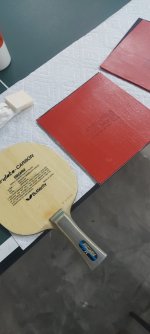says
toooooo much choice!!
says
toooooo much choice!!
Well-Known Member
But what does the "touchy feelly" time have to do with the equipment?
You guys are talking about the player using the 'feel' of impact to modify strokes.
These are two different discussions.
The OP have made it clear this thread is about the blade not perception. The rest is off topic.
Tell us all. Would this blade feel like it has more "dwell time" because if vibrates longer?
[video]https://deltamotion.com/peter/TableTennis/Toxic%205%20in%20Vise.mp4[/video]
You can see the contact time is short compared to the time the paddle vibrates.
This video shows why JRS Dallas' research was misguided. Look at it carefully.
The video is shot at 2000 FPS but the paddle is in a vice so I didn't need to stand in front of hot halogen lamps.
What you should notice is that the ball leaves the paddle before the paddle can spring back to aid in the pushing the ball back. All the paddle absorbs a lot of energy when being pushed back that isn't returned to the ball. Yet you can see the paddle almost shimmer with higher frequencies that also don't help in pushing the ball back. A faster paddle will will bend a little at contact but maintain contact with the ball as it springs back. This will result in more of the impact energy being transferred back to the ball.
It is the primary mode of vibration that is important, not the fourth.
Ideally the paddle will rebound and keep in contact with the ball as long as possible to return more energy if that is what is desired. This really should be looked at through the lens of a spring board diver where the spring board is adjusted or 'tuned' be vibrate in sync with the diver.
Hi BB, please don’t take this post the wrong way, I don’t mean any disrespect and I am not trying to find fault, you are far far more qualified, knowledgeable and experienced than myself on these topics. I’m just trying to learn and see if my thoughts are somewhere near the mark, as it were!!
Touchy feely time, or perhaps the touchy feely information conveyed and received for a given impact is surely dependent on the equipment used combined with the type of impact. ??
the video was great, clearly showed the vibrations.
I take it that if the clamp were slightly looser the amount of vibration seen would be less ?? Or is that a misconception I’m making?
if the blade had a softish sponge only on it, the amount of vibration would be less?? ( if sponge absorbs impact forces)
if the sponge was harder then the vibration seen would be more than soft sponge but less than blade only??
The OP asks for ‘which blade has the longest dwell time’ so unless someone has measured the dwell time for every blade out there no one can really comment !!
Especially as the duration of impact / dwell time is really very small !!
and I would think that for a given impact Such as in the video clip, the measured differences of impact duration / dwell time for different blades are even smaller!!!
impact duration / dwell time for a different type of impact, with a blade only, say brushing impact, I (we) assume [ makes an ASS out of U and ME or could do!!) would be longer?? Blade with sponge and top sheet longer still.
Now the touchy feely information received is changed.
would the blade feel like it has more ‘dwell time’ because it vibrates longer?? Dunno !!! Reckon it would feel pretty wooden though!!!
if we can’t really comment on dwell time, then what do we have left?? The ‘feeling’ received / perceived from the impact event. So I think that’s why we talk about dwell time in terms of feeling.
These threads are ‘old hat’ to a lot of the members, but to those of us new to this site, they are as bright as a shiny new button!! So please keep going!!!!
regards
IB66










